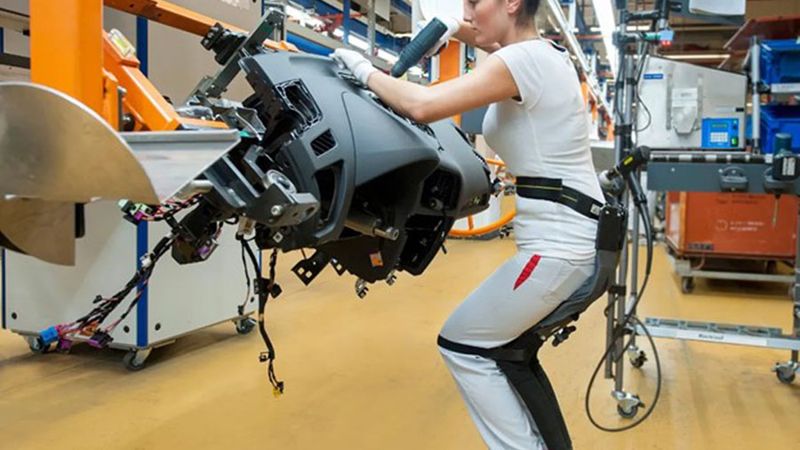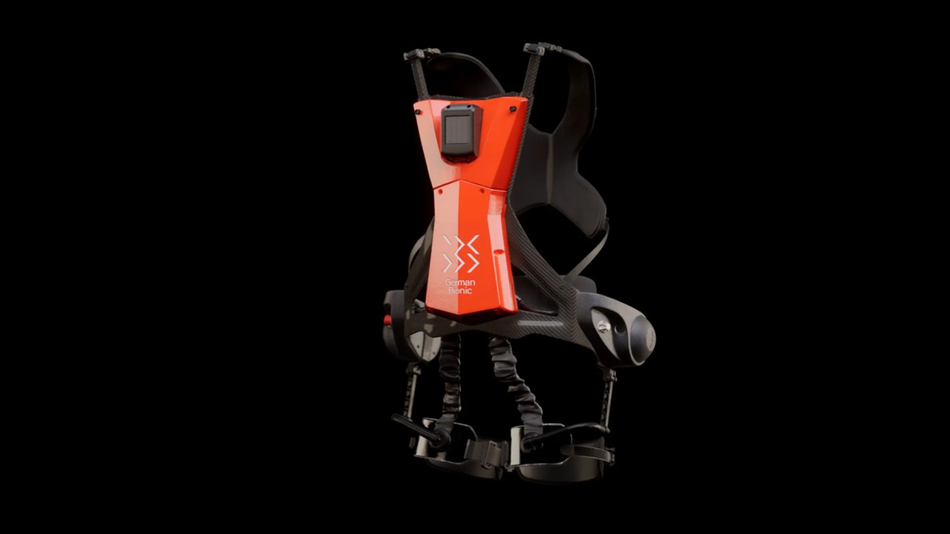Could carbon fiber exoskeletons become common assistive wear for workers?
Exoskeletons made with carbon fiber composites using cutting-edge manufacturing techniques can assist workers in performing repetitive tasks.
Carbon fiber has made its way into the design and manufacturing of many different products, and that’s because of its impressive performance. One of its most recent cutting-edge applications is human exoskeletons. Imagine wearing a carbon fiber structure over your clothes to assist you at work.
There are already exoskeletons on the market to help humans perform better, work safer, and even monitor their health and strain through the Internet of Things (IoT). But there still remain challenges associated with the manufacture of carbon fiber parts for these to become mainstream items. In this article, we’ll discuss what an exoskeleton is and why carbon fiber is an excellent material to use. We will also look at current trends for manufacturing carbon fiber composite parts, as well as the challenges and how we might be able to innovate to overcome those roadblocks with engineering ingenuity.
What are exoskeletons?
An exoskeleton, as the term implies, is when the skeleton is external on a living creature. Typically, exoskeletons are seen in nature on animals such as spiders, clams, and other insects. [1] But increasingly, the term exoskeleton is being used to describe a similar structure used to support humans. In this case, the exoskeleton is a piece of equipment a person wears externally that can assist them by providing increases in strength and stability.
Human exoskeletons can be purely mechanical, meaning the structure itself supports the worker through elements, such as the frame, hinges, and possibly springs. Exoskeletons can also be electrical and mechanical, incorporating the assistance of an electric motor. For example, the German Bionic exoskeleton in the image below supports a worker’s lower back with two servo motors and a carbon fiber frame. The purpose of the exoskeleton is to prevent injuries when workers are performing repetitive operations, including lifting, carrying, and squatting.
Why is carbon fiber an excellent choice for exoskeletons?
Carbon fiber is being used in many engineering disciplines to replace structures previously constructed with steel or aluminum, because of its strength and stiffness. In order to compare the strength of materials we can examine the ultimate tensile strength. Carbon fiber has an ultimate tensile strength of ~3,500 MPa.[2] Aluminum has an ultimate tensile strength of 70 MPa and steel (ASTM-A36) has an ultimate tensile strength of ~400 MPa. [3]
To compare the stiffness of materials we can use Young’s Modulus, which is also the ratio of stress over strain. Carbon fiber reinforced plastics (CFPR) have a Young’s Modulus of ~150 GPa, while aluminum alloys are ~70 GPa and steel is ~200 GPa.[3] These are average figures, and the exact composition of the material will determine the precise Young’s Modulus, but as you can see, carbon fiber composite materials have similar stiffness to traditional metals used in structures and machinery. These composites also have two important advantages over traditional metals when it comes to building an exoskeleton.
First, composites are much lighter than metals making it easier for workers to wear the exoskeleton and be assisted through repetitive tasks. Second, carbon fiber has the ability to be molded into a complex geometry fairly easily. In comparison, metals must be bought in a certain shape or must have a complicated die designed to form parts. But if you use carbon fiber, you create the part on a mold, using a precise lay-up. This means you can precisely maximize strength and stiffness for your design with minimal mass.
Depending on the specific carbon fiber composites you use, you “lay up” the sheets of fibers in a specific pattern to generate the material properties you require. Again, this is a benefit for the exoskeleton that can be manufactured to support the complex geometries of the human body and the variations in size and shape seen across the population.
Current trends in carbon fiber composite manufacturing
The most common carbon fiber manufacturing methods are still rather labour-intensive. The first method is wet lay-up, which is where the carbon fiber sheets are placed or “laid up” into the mold and the resin is applied by brush, brush[DI1] , or spray gun. The second is preglamination, where the sheets of carbon fiber have already been infused with the resin, and after they are laid up in the mold, they are cured in an autoclave. The third is resin transfer molding (FRM), which lays up the fiber sheets into a special mold that will be sealed shut and resin is injected at high pressures. [4]
To assist each of these methods, 3D printing has been applied at different stages of the process. The molds themselves are now being created using a 3D printer, which results in a more accurate product that requires less rework and surface geometry quality control than a hand-built or cut mold. In addition, there have been advancements in 3D printing the actual carbon fiber composites, using either a resin with chopped fibers embedded or by printing continuous fibers in the horizonal plane for strategic strength and reinforcement of the polymer. [4]
Challenges associated with carbon fiber composites
Depending on the material requirements, budget, and available skilled labour, any of the methods we mentioned could be used to manufacture a carbon fiber exoskeleton. However, many of these methods are time-consuming, labor-intensive, and very precise, meaning human error in these processes happens quite often. And while some error or variation can be eliminated by using prepreg materials or RFM in order to standardize the amount of resin used, there can still be variation in lay up.
Large-scale manufacturing of carbon fiber composites for many different applications share common challenges. Finding, training, and retaining talent to manufacture molds, lay up fiber sheets, and perform quality control are roadblocks for many businesses. While the trends in using 3D printing in some aspects of manufacture could help alleviate the burden on the human labour required, these processes are still expensive and time-consuming. There is a real need in the market for solutions to overcome the challenges of manufacturing carbon fiber components.
Overcoming manufacturing challenges using carbon fiber from Mitsubishi Composites Toolbox
Mitsubishi Chemical Group has developed the Composites Toolbox, a combination of high-quality composite materials, experts, and manufacturing methods to rewrite what’s possible in engineering. By replacing traditional materials with composite solutions that meet future performance, consumer, and sustainability requirements, more engineers can help optimize several applications.
The Composite toolbox includes a variety of materials; ranging from glass, carbon, or natural fiber reinforcements with a thermoset or thermoplastic matrix. A reduction of the environmental footprint can be obtained with low carbon footprint solutions, such as” recycled carbon fiber (rCF), recycled thermoplastics, or biobased thermoset resins.
Are you using manual layup and think you need to compromise on freedom of design? The design freedom of some of these materials, such as KyronTEX, enables new designs at scale with high process efficiency due to the elimination of various intermediate process steps.
Composite Engineering Challenge
Mitsubishi Chemical Group is inviting innovators, entrepreneurs, and early adopters at universities, (pre-) startups, and scaleups that need fiber-reinforced composites to realize their prototype, part, product, or application.
We welcome projects, programs, and companies in the field of new mobility (EV, e-motor, battery casing, etc.), autonomous (delivery) vehicles, people movers, robotics, aerospace, space, bicycles, UAV, AAV, bionics (wheelchairs, exoskeletons, prosthetics), alternative energy (production, storage, transport), self-sensing or self-healing, sport & leisure, alternative (low carbon footprint) fibers and more!
The winning entry will be rewarded with a partnership with Growth Garage, Business Incubator of the MCG Advanced Materials Division.
This partnership package is valued at $25,000 and will be tailored to the winning team’s needs according to their current business and product development stage.
Read more about the challenge here.
Key Dates
| Composite Challenge Launch | Monday, October 24th, 2022 |
| Challenge Close | Sunday 22 January 2023 |
| Finalists Announced | Wednesday 1 February 2023 |
| Wevolver Community Vote | From 1-12 February 2023 |
| Winners announcement | Tuesday 21 February 2023 |
About Mitsubishi Chemical Group Advanced Materials Division and Business Incubator Growth Garage
MCG Advanced Materials Division is a leading global manufacturer of high-performance materials in the form of semi-finished products and finished parts. The company has locations in 20 countries and more than 2,800 employees. Its specialty engineering thermoplastics and composites are superior in performance to metals and other materials and are used in a wide range of applications, primarily in the capital goods industry. The company is continuously developing new areas of applications in close cooperation with industry leaders in a wide variety of customer markets.
Growth Garage is the Business Incubator of the MCG Advanced Materials Division. Our mission is to support and grow new ideas using our technologies and advanced engineering materials to help tackle some of today's biggest engineering challenges. We are offering the opportunity for engineers and innovators to pitch us their ideas and receive manufacturing support and services.
References
- Encyclopedia Britannica [Internet]. Exoskeleton c2017 Jan 31 [cited 9 Nov 2022]. Available from: https://www.britannica.com/science/exoskeleton-anatomy
- Dragonplate.com [Internet]. What is carbon fiber? c2022 [cited 16 Nov 2022]. Available from https://dragonplate.com/what-is-carbon-fiber#:~:text=The%20stiffness%20of%20a%20material,500%20ksi%20(3.5%20Gpa)
- The Engineering ToolBox [Internet]. Young’s Modulus, tensile strength and yield strength values for some materials c2003 [cited 16 Nov 2022]. Available from https://www.engineeringtoolbox.com/young-modulus-d_417.html
- Formlabs.com [Internet]. How to manufacture carbon fiber parts c2022 [cited 16 Nov 2022]. Available from https://formlabs.com/blog/composite-materials-carbon-fiber-layup/




